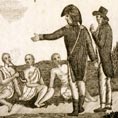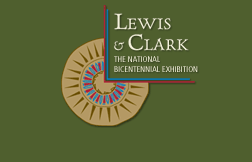
IMAGE GALLERY
 |
 |

Access the Image Gallery to see all images, objects, and documents used in this lesson plan.
 |
View Image Gallery

|

|
 |



Lesson Plan 1: Lewis and Clark—Diplomats or Soldiers?
OBJECTIVES
Students will:
- define "diplomat" and "diplomacy"
- identify three goals that President Thomas Jefferson wanted Lewis and Clark to achieve in their dealings with the Indian tribes
MATERIALS
| IMAGES |
"Captains Lewis & Clark Holding a Council with the Indians." Sketch in P. Gass, A Journal of the Voyages and Travels of a Corps of Discovery, 1810
"Captain Lewis Shooting an Indian." Sketch in P. Gass, A Journal of the Voyages and Travels of a Corps of Discovery, 1810
Photograph of Secretary of State Colin Powell from: www.state.gov/secretary/
|
STUDENT
READINGS |
Excerpts from Jefferson's Letter to Lewis, June 20, 1803 (PDF)
Excerpts from Jefferson's Letter to Lewis, January 22, 1804 (PDF)
|
ACTIVITY
SHEET |
Vocabulary Sheet for June 20, 1803, Letter (PDF)
Vocabulary Sheet for January 22, 1804, Letter (PDF)
Analyze the Sketches (PDF)
Map of Louisiana Purchase (PDF)
|
| SUPPLIES |
Overhead Projector for Projecting Visuals
Large Chart Paper for Recording Findings
|
OPENING
Display the photo of Secretary of State Colin Powell. Ask: "Who is this man?" (Answer: Secretary of State General Colin Powell). "Where have you seen his photograph before?" (Answer: TV, newspapers, magazines). "In what ways were Lewis and Clark and Secretary Powell alike?" They are alike in at least three ways:
- Secretary Powell is a diplomat who represents the U.S. and talks to representatives of other nations trying to make friendships and agreements in the interest of the U.S. Lewis and Clark were diplomats for the U.S. also.
- Before becoming a diplomat, Secretary Powell was a general in the U.S. Army. Lewis and Clark were also officers in the U.S. Army.
- Secretary Powell works for President Bush. Lewis and Clark worked for President Jefferson.
Tell students: In this unit we are going to learn how Lewis and Clark acted as diplomats (and also as soldiers) representing the United States and President Jefferson to Indian tribes in the West.
PROCEDURE
- Say to the students: "President Jefferson sent a letter to Meriwether Lewis in the summer before the Corps started the expedition. The letter told Lewis exactly what President Jefferson expected and what the mission was to accomplish. We are going to look at the part of the letter that told Lewis and Clark how to deal with the Indian tribes."
- D
 istribute (or project) copies of excerpts from President Jefferson's letter to Lewis dated June 20, 1803, and read the letter with the class. A content-vocabulary page is included and may be used to help the students read the letter independently, or the letter may be read/discussed as a whole-class activity. istribute (or project) copies of excerpts from President Jefferson's letter to Lewis dated June 20, 1803, and read the letter with the class. A content-vocabulary page is included and may be used to help the students read the letter independently, or the letter may be read/discussed as a whole-class activity.
- Ask the students to respond to these questions in a class discussion and record their answers on a large chart that has these headings:
Jefferson's Directions to Lewis and Clark
Concerning Diplomacy with the Indian Tribes |
Behave: |
Tell the Tribes: |
Find Out About: |
Keep and display this chart for reference throughout the unit.
QUESTIONS:
- how does this letter tell Lewis and Clark to treat the Indian tribes they meet?
- do you see any clues in this letter that suggest President Jefferson sometimes would want Lewis and Clark to act in a less friendly way towards the Indian tribes?
List the ways President Jefferson wanted Lewis and Clark to behave in dealings with the Indian tribes in the correct column on the class chart.
List all the things that President Jefferson wanted Lewis and Clark to tell the tribal leaders in the correct column on the class chart.
List all the things that President Jefferson wants Lewis and Clark to find out about the Indian tribes on the class chart.
Questions for students to consider:
- Why do you think President Jefferson wanted all this information about the Indian tribes?
- What do you think the Indian tribes thought of Lewis and Clark gathering all this information about them? Do you think the Indians were just as curious about Lewis and Clark? Why or why not?
Responses to behave should include:
- be friendly (if the Indians allow)
- be polite
Responses to tell should include:
- tell tribes that United States doesn't intend to hurt them
- tell tribes that the U.S. is strong
- tell the tribes that the U.S. will set up trading posts to trade with them
Responses to find out about should include:
- find out the names of the nations (tribes) and how many people each has
- find out where each tribe lives and hunts
- find out how tribe gets along with other tribes
- find out each tribe's language, traditions, and monuments
- N
 ext, tell the students: "After President Jefferson wrote the above letter to Meriwether Lewis on June 20, 1803, the United States purchased the Louisiana Territory from France in December 1803.The Corps of Discovery was spending the winter at Camp Dubois near St. Louis at that time. The men were encamped at Wood River (just northeast of St. Louis on the east side of the Mississippi) waiting for good spring weather before they set out on their expedition. During that winter of 1803-1804 Captain Lewis was in St. Louis gathering supplies when he received another letter from President Jefferson dated January 22, 1804." ext, tell the students: "After President Jefferson wrote the above letter to Meriwether Lewis on June 20, 1803, the United States purchased the Louisiana Territory from France in December 1803.The Corps of Discovery was spending the winter at Camp Dubois near St. Louis at that time. The men were encamped at Wood River (just northeast of St. Louis on the east side of the Mississippi) waiting for good spring weather before they set out on their expedition. During that winter of 1803-1804 Captain Lewis was in St. Louis gathering supplies when he received another letter from President Jefferson dated January 22, 1804."
In the second letter, President Jefferson added a new diplomatic mission for the captains. According to the U.S. perspective, much of the region through which the Corps would be traveling was now claimed by the United States because of the land purchase, so the captains were directed to let the Indian nations they encountered know of this new development.
- Project a copy of the letter dated January 22, 1804, and read through it with the students. Initiate a class discussion about the new message President Jefferson asked Lewis and Clark to give to the Indian tribes in this second letter.
After the class discusses the new directive, add to the large classroom chart these statements:
- tell Indian tribes they no longer have Spanish/French fathers
- tell Indian tribes they have a new father and protector (the U.S.)
- tell Indian tribes Americans will set up trading posts for them
This might be a good place to break this lesson.
- Tell the students they will look at two sketches of actual encounters that Lewis and Clark had with Indian tribes. Explain that these sketches were printed in a book written in 1810 by Patrick Gass, one of the men who traveled on the expedition with Lewis and Clark. Explain that Gass described the scenes to an artist who then drew them.
- Project (or distribute copies of) the sketches one at a time. Ask students to look at each sketch and complete the sketch analysis sheet. You may choose to have the students work in groups, pairs, or individually. You may want some groups or pairs to analyze one sketch and some the other.
- When the students have finished their analyses, have them share their responses with the entire class. Information to share about the sketches is given below. It comes from Carolyn Gilman's book Lewis and Clark: Across the Divide.
Sketch #1 is titled "Captains Lewis and Clark holding a Council with the Indians" (1810). Tell the students that, "The uniforms are accurate; the Indian togas are not. The person beside Lewis is probably the translator." The council depicted is possibly the one Oto and Missouri Indians held in the vicinity of present-day Council Bluffs, Iowa. Below is a short excerpt of the speech Lewis gave to the Otos at this meeting:
Children. Commissioned and sent by the great Chief of the Seventeen great nations of America, we have come to inform you, as we go also to inform all the nations of red men who inhabit the borders of the Missouri, that a great council was lately held between this great chief of the Seventeen great nations of America, and your old fathers the French and Spaniards; and that in this great council it was agreed that all the white men of Louisiana, inhabiting the waters of the Missouri and Mississippi should obey the commands of this great chief; He (The great Chief) has accordingly adopted them as his children and they now form one common family with us; your old traders are of this description; they are no longer the subjects of France or Spain, but have become the Citizens of the Seventeen great nations of America, and are bound to obey the commands of their great Chief the President who is now your only great father...
....he has sent by us, one of his flags, a medal and some clothes, such as he dresses his war chiefs with, which he directd should be given to the great chief of the Ottoe nation, .....when you accept his flag and medal, you accept therewith his hand of friendship, which will never be withdrawn from your nation as long as you continue to follow the councils, which he may command his chiefs to give you, and shut your ears to the council of the Bad birds."
Sketch #2: "Captain Lewis shooting an Indian." Tell the students that, "The artist who illustrated Patrick Gass's journal portrayed Lewis's fatal encounter with the Blackfeet this way. Gass was not an eyewitness, since he was making the Great Falls portage at the time. Only three men were with Lewis. The man in the capote is probably intended to be Drouillard." * Note: Captain Lewis shot and killed one Piegan Blackfeet Indian, and Private Reubin Field stabbed another on the return trip in 1806. Lewis and several of the men were away from the rest of the Corps when they had a chance encounter with some Blackfeet Indians. The Blackfeet attempted to take some of the American's horses, and in the resulting conflict, Lewis shot and killed the two Blackfeet. For more information see Ronda's Lewis and Clark among the Indians, pp. 238-244, or Lewis' journal entry about the Blackfeet incident (July 27, 1806, pp. 437-439 in The Journals of Lewis and Clark, edited by Bernard DeVoto.)
- Finally, ask the students how the sketches might have been different if an Indian artist who witnessed the events had drawn them. Hide paintings are used by Plains Indians to depict historic events. Students could draw a hide painting of this event. See the Smithsonian's "Tracking the Buffalo: Stories from a Buffalo Hide Painting" Web site at www.americanhistory.si.edu/hohr/buffalo/index.html for more information.
Extension activity: If students wish, have them draw a sketch as an Indian who witnessed the tribal council (or the shooting) might have drawn it. Have them write a sentence or two at the bottom of what the Indian might have said.
CLOSING
Have a student read from the class chart the diplomatic goals President Jefferson gave to Lewis and Clark. Then ask students if they think Lewis and Clark were always successful in living up to President Jefferson's expectations.
SUGGESTED FORMATIVE ASSESSMENT
- Ask the students to take the role of diplomat Meriwether Lewis, and to write a four-to-five-sentence speech that he might have given to an Indian tribal chief he met on the journey west.
- Have students take the role of the chief to whom this speech might have been given. Write a short paragraph telling what that chief might have thought about it. The option could be allowed to give and respond to the speech orally.
To show mastery of the objectives, student speech should include three or more of the following directives given by President Jefferson:
- The Spanish are no longer your fathers.
- We are your new fathers.
- We are your friends.
- We will protect you.
- We will set up trading posts where you can trade pelts for goods.
- Please tell us the name of your tribe and how many of you there are.
- Please tell us where you live and how far away you travel.
- Please tell us about your language.
- Please tell us about your traditions/monuments
- Please tell us about other tribes you know and how you get along with them.
The response by the chief might include some of these points:
- We have had other fathers, why do we need a new one?
- We can make our own agreements with other tribes.
- Your speech makes it sound like we must have your approval for everything we do, but we have minds of our own.
- We look forward to trading with you.
- We are glad you are going to be our allies in war.
- Thank you for the gifts.
[PRINTABLE VERSION]
|
 |








